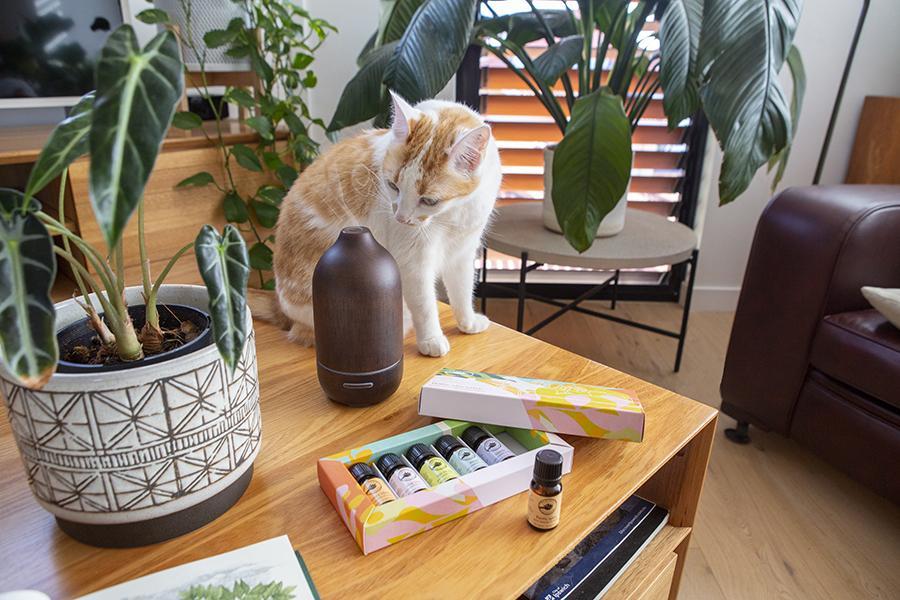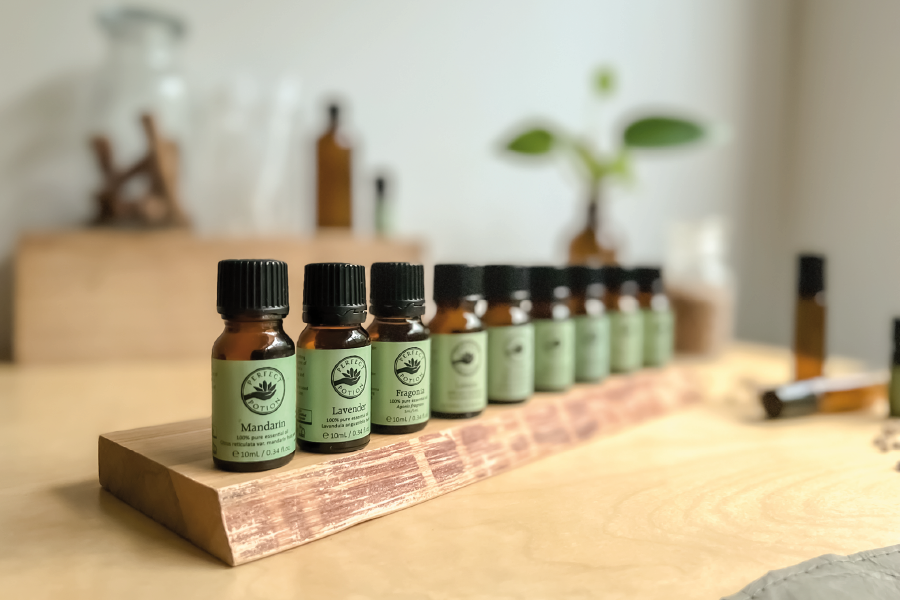Why is it that there is still so much misinformation regarding the safe use of essential oils around cats?
Several years ago, I wrote a blog to dispel the concern that it is not safe to diffuse essential oils around cats. I have had cats and dogs all my life, and have worked with essential oils for most of my life. I certainly do not want to expose my furry loved ones to any hazardous substances, and can completely respect wanting to take the cautionary path. However, it’s important to be able to discriminate facts. Being properly informed is of utmost importance.
I err on the side of caution with the following points on pet safety with essential oils:
- Do not apply essential oils topically to your cat.
- Never allow your cat to ingest essential oils.
- When diffusing, ensure the room is well ventilated and that your cat is able to leave the room.
However, there is still so much misinformation circulating about essential oil safety and cats. A quick Google search for “essential oils, safety, and cats” will unearth more than 9.87 million results.
So, how do you know which sources to trust?
Go to veritable sources with extensive knowledge on the topic. Focus on websites and books authored by veterinary medicine schools, practitioners, researchers and other experts in animal health and wellbeing. Fact-check all your information, and read the full study – as often times, misinformation and disinformation stems from pulling out-of-context phrases from properly cited, peer-reviewed articles to portray a different narrative.
Let me now investigate the origins of this misinformation to fact-check various claims…
Fact-check:
Are essential oils hazardous to cats?
Household Plants Toxic to Cats
Several veterinary medical papers state the following common house plants are toxic to cats, and can make them incredibly ill and potentially be fatal:
- Poinsettias
- Lilies
- Holly
- Tulips
- Baby’s Breath
- Hydrangeas
… Just to name a few.

Household Cleaners & Garden Items Toxic to Cats
Common household and garden items also listed as toxic, hazardous, and potentially fatal for cats include:
- Pesticides
- Fertilizers
- Weed Killers
- Snail Bait
- Ethylene Glycol Antifreeze
- Paint Thinner
- Swimming Pool Chemicals
- Bleach
- Detergents
- Disinfectants
Which Essential Oils are Toxic for Cats?
When it comes to essential oils, they are hazardous to cats when ingested, applied to their sensitive skin, or used on their fur (which they may ingest when self-grooming).
I was surprised with the extensive list of essential oils considered toxic to pets: basil, bergamot, bitter almond, cinnamon, clove leaf, eucalyptus, geranium, juniper, lavender, lemon, lemongrass, lime, mint, myrrh, orange, pine, rose, rosemary, sandalwood, sassafras, tarragon, tea tree, wormwood and ylang ylang.²
There are some essential oils on this list that I consider very hazardous even for humans, such as bitter almond, sassafras, and wormwood.
There is also no consistency between various lists of toxic oils, with many websites contradicting one another. For example, some lists state that eucalyptus is safe for cats, while others state the opposite and that eucalyptus is toxic for cats.
It would appear that the origins of which oils are toxic to cats involve limonene and phenols – which I explore extensively in this comprehensive blog.
However, so long as you exercise caution and follow instructions when diffusing essential oils around your cat, they should not be hazardous to your cherished companion.

Veterinary Cautions when using Essential Oils with Cats
One veterinary medicine school raises concerns about the potential respiratory irritation that may be caused when the cat inhales an essential oil.²
Symptoms of respiratory irritation include:
- Watery nose and eyes
- Drooling
- Vomiting
- Difficulty breathing*
*Difficulty breathing can easily be distinguished from expelling a furball as the cat crouches low to the ground with little abdominal movement and no furball production.²
The professor authoring the article explains that by diffusing the essential oil, you release micro-droplets into the air which may collect on the fur of your cat; which may accidentally ingest the essential oil when it grooms itself.²
This all leads to the point that you should not diffuse essential oils in an enclosed space around pets - especially when you to not allow your cat the option to vacate the area in which the diffuser is placed.
Pet owners should also exercise caution when using essential oils around cats, as they may tip over the diffuser and accidentally ingest the spilled oils.
FACT-CHECK:
Myths and Misinformation surrounding cats and essential oils
Misconception: Cats cannot metabolise essential oils.
Fact: Tisserand explains cats almost completely lack important liver enzymes that humans possess, which are important in the metabolism of many essential oil constituents. They have a much slower elimination time compared with dogs and other animals. Therefore, there is a theoretical risk of increased toxicity to cats. However, this is likely to be from ingestion or topical application of large quantities of neat essential oils, not from inhalation.7
The misconception that cats are deficient in liver enzymes responsible for metabolizing certain essential oil constituents may have started with a 1972 research article examining the toxicology of benzyl alcohol to cats.8
This original paper examined the toxicosis in cats from the use of benzyl alcohol in lactated ringer’s solution. This is most likely where the precaution of using any substance with phenols came about. If we look closely at this study, benzyl alcohol was injected into the cats.9
However, it is true that cats have a much slower elimination time compared to dogs and other animals.
Misconception: Citrus oils are toxic to cats.
Fact: Many citrus oils are listed as toxic for cats. This may have come about because a 1980s study examining the effects of extremely high doses of a flea repellant containing limonene, one of the main constituents found in many citrus oils.
In this study, no clinical sign of toxicosis was reported at the manufacturer’s recommended concentration. However, at 5 times the recommended concentration, clinical signs were mild and consisted of hypersalivation of short duration, ataxia, and muscle tremors resembling shivering. At 15 times the recommended concentration the same clinical signs lasted up to 5 hours.10
This study involved extremely high topical doses well above recommended concentrations for cats, however the misconception emerged that citrus oils are toxic to cats.12
Misconception: There are certain essential oils that should not be diffused with cats.
Fact: The internet is rife with misleading and contradictory information on which essential oils may or may not be toxic for cats. These long lists of essential oils that are either ‘safe’ or ‘toxic’ to cats do not make much sense at all, and as Tisserand states: it’s more about the overall exposure.
He explains you can diffuse small amounts for limited periods of time so long as there is good ventilation and your cat has the freedom to leave the room if it wants.7
Toxicity is very much dose dependent and I am adamant that the dosage of essential oil that may be inhaled through diffusion is extremely small and unlikely to be toxic. You can read my full analysis on these various lists in my comprehensive blog here.
How To Use Essential Oils Safely With Cats
Let’s make a summary of some of the good advice regarding the use of and diffusion of essential oils around cats:5,13
- Always store essential oils away from your cat.
- Always ensuring there is sufficient ventilation in the room.
- Ensure the diffuser cannot be reached by your cat.
- Ensure your cat is able to have access to leave the area.
- Always wash your hands after handling essential oils before touching your cat.
- Always use pure high quality essential oils.
- Looking out for signs of an intolerance to an essential oil such as squinting, excessive drooling, scratching, increased breathing rate and lethargy.
- If you notice any strange behaviour from your pet, or your pet accidently ingests essential oils, contact your vet immediately.
Personal Anecdote
We have diffused essential oils with our furry loved ones for nearly our whole lives. Our Abyssian cat Memsahib lived for 16 years and not once did she display any signs of overexposure or illness caused by essential oils. Our cat Abbey, featured in these photos, is happy and healthy surrounded by aromatherapy.

Left: Sal with his Abyssian cat Memsahib | Right: New cat Abbey with Lucy the beagle
Authored by

Salvatore Battaglia
Aromatherapist | Owner & Founder of Perfect Potion
References
2. https://vetmed.tamu.edu/news/pet-talk/a-scent-sitive-subject-essential-oil-diffusers-and-your-cat/
3. MacLeod E. Essential oils for cats – the complete essential oil guide for cats! Protect your beloved family member from diseases and illnesses by using essential oils. Recipes included! Spirit Publishing, 2015.
4. Ross M. Essential oils for cats – safe & effective therapies and remedies to keep your cat healthy and happy.
5. https:/www.floraandfauna.com.au/blog/essential-oils-and-your-pets
6. Hendley S. Essential oils and oil diffusers could be harming your pet. Downloaded on 4 April 2022 from https://www.abc.net.au/everyday/are-your-essential-oils-and-diffusers-hurting-your-pet/100107687
7. Tisserand R. Cats and Essential oil safety. Downloaded on 4 April 2022 from https://tisserandinstitute.org/cats-essential-oil-safety/
8. Shelton M. The science behind cats and essential oils. Downloaded on 4 April 2022 from http://www.mcconnellsburvet.com/the-science-behind-cats-and-essential-oils
9. Court MH. Feline drug metabolism and disposition: pharmacokinetic evidence for species differences and molecular mechanisms. Veterinary Clinics: Small Animal Practice. 2013;43(5). doi: 10.1016/j.cvsm.2013.05.002
10. Hooser SB et al. Effects of an insecticidal dip containing d-limonene in the cat. Journal of the Veterinary Medical Association, 1986;189(8):905-8.
11. Hooser SB. D-limonene, linalool and crude citrus oil extracts. Veterinary clinics of North American: Small animal practice. 1990;20(2):383-385. doi: 10.1016/S0195-5616(90)50032-7
12. Hink WF, et al. Toxicity of d-limonene, the major component of citrus peel oil, to all life stages of the cat flee, Ctenocephalides felis (Siphonaptera: Pulicidae) Journal of Medical Entomology. 1986;23(4):400-4. doi: 10.1093/23.4.400



